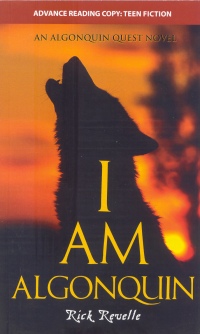| ________________
CM . . .
. Volume XIX Number 41. . . .June 21, 2013
Rick Revelle, a member of the Ardoch Algonquin First Nation, says he wrote I Am Algonquin because of the widespread "ignorance and lack of information" about native people. In his "Author's Note", he explains that First Nations people cannot be "lumped into one linguistic or cultural group" but are a series of nations "in a Nation called Turtle Island." "European people said that they were created in Europe," he continues, "but when we say that we were created in Turtle Island, they point out, 'oh, no, you crossed the Bering Strait'." Then Revelle asks, rhetorically, "What right do they have in telling us this?" I, an elderly Canadian of European ancestry, was never taught that Europeans were "created" in Europe. Scientists believe that humankind originated in Africa and moved through the ages in waves of migration all over the world. If all human beings' ancestors moved around the globe, then why is the Bering Strait theory disrespectful or derogatory? Otherwise, Revelle deserves applause for his extensive research, not only on the Internet but in six Canadian museums and 15 books listed in the bibliography. His objective was to be as "historically accurate as possible" in writing about the way of life of the Omamiwinini (Algonquins) of the early 1300s. Most of the story is told in the first person through Mahingan, a young married warrior who lives with his wife and her relations in a band of around sixty men, women and children in what is now the Ottawa area. In the summer months, starting with the Flower Moon and Strawberry Moon, five family units meet to hunt, fish, collect berries and live as a larger village. In winter, they split into smaller units so as not to over-hunt an area. Hunting is a vital pursuit which brings Mahingan and his male relatives into challenging confrontations with wild animals and other native people seeking a food supply. Early in the novel, readers see them kill a moose and then fight Nipissing warriors in the area. The novel continues in this vein. The primary enemy are the Haudenosaunee (Iroquois) who live east of the Omamiwinini. I Am Algonquin will appeal to young male action/adventure fans who agree with Mahingan that "There was nothing like the thrill of a hunt to make me feel like my blood had been given a sudden rush through my veins." Whether it be wolverines attacking an old bull moose, prisoners being forced to run the gauntlet, or Mahingan and his fellow warriors corralling and slaughtering buffalo, Revelle's descriptions are detailed and graphic. Because survival was so difficult, it is not surprising that Mahingan seldom shows his gentler side. (I was surprised to find buffalo in a novel set in eastern North America, but reminded myself that the novel takes place in the early 1300s when the North American climate, vegetation, etc. would have been unlike that of 2013. Revelle explains that "these beasts were able to come to our hunting ground only when the big lake completely froze over during the winter.") Revelle frequently mentions the work that the women do and the importance of their reproductive capability for the band's survival. He refers to the Algonquin and Huron cultures as "matriarchal", describing a "matriarchy" as a system in which a warrior who marries goes to live with his wife's family, treats his mother-in-law with great respect, and supports and fights for the family unit made up of his wife's relatives. Revelle writes that women "wielded so much power" because they "brought warriors to the family unit, strengthening the village." In this novel, readers don't see women participating in decision-making councils. Two of Revelle's minor characters are unique in being female warriors. These former girlhood friends who chose to train as fighters live together with the band's approval. Mahingan's wife also plays a minor role. The novel switches from Mahingan's point of view to hers during the childbirth scene and when she hides their baby to save it from a Haudenosaunee attack. The author's 10 page glossary and pronunciation guide is helpful to those who have heard of "Algonquin", "Huron" and "Iroquois" but not of "Omamiwinini", "Ouendat" and "Haudenosaunee". Revelle makes good use of cliffhangers; that is, he poses a question at the end of each chapter to pique readers' interest and lead them to read on. Action scenes alternate with quieter ones and with passages of information. Indeed, I Am Algonquin contains such a wealth of information that anyone teaching this period might consider using it as a textbook. Recommended. Ruth Latta's teen novel, The Songcatcher and Me, (Ottawa, Baico, 2013) is set in the twentieth century. For information on Ruth Latta's books, please visit her website, www.cyberus.ca/~rklatta/RuthLatta.html or her blog, http://ruthlatta.blogspot.com.
To comment
on this title or this review, send mail to cm@umanitoba.ca.
Copyright © the Manitoba Library Association. Reproduction for personal
use is permitted only if this copyright notice is maintained. Any
other reproduction is prohibited without permission.
NEXT REVIEW |
TABLE OF CONTENTS FOR THIS ISSUE
- June 21, 2013.
AUTHORS |
TITLES |
MEDIA REVIEWS |
PROFILES |
BACK ISSUES |
SEARCH |
CMARCHIVE |
HOME |
